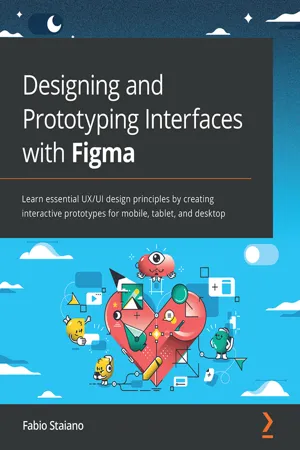
- 382 pages
- English
- ePUB (mobile friendly)
- Available on iOS & Android
Designing and Prototyping Interfaces with Figma
About this book
Discover user experience and user interface design best practices while mastering a wide array of tools across Figma and FigJam with this full-color guide
Key Features
- Learn the basics of user experience research, result organization, and analysis in FigJam
- Create mockups, interactive animations, and high-fidelity prototypes using this platform-independent web application tool
- Collaborate with a team in real-time and create, share, and test your designs
Book Description
A driving force of the design tools market, Figma makes it easy to work with classic design features while enabling unique innovations and opening up real-time collaboration possibilities. It comes as no surprise that many designers decide to switch from other tools to Figma.In this book, you'll be challenged to design a user interface for a responsive mobile application having researched and understood user needs. You'll become well-versed with the process in a step-by-step manner by exploring the theory first and gradually moving on to practice. You'll begin your learning journey by covering the basics of user experience research with FigJam and the process of creating a complete design using Figma tools such as Components, Variants, Auto Layout, and much more. You'll also learn how to prototype your design and explore the potential of community resources such as templates and plugins.By the end of this Figma book, you'll have a solid understanding of the user interface workflow, managing essential Figma tools, and organizing your workflow.
What you will learn
- Explore FigJam and how to use it to collect data in the research phase
- Wireframe the future interface with shape tools and vectors
- Define grids, typography, colors, and effect styles that can be reused in your work
- Get to grips with Auto Layout and the constraints to create complex layouts
- Create flexible components using styles and variants
- Make your user interface interactive with prototyping and smart animate
- Share your work with others by exporting assets and preparing development resources
- Discover templates and plugins from the community
Who this book is for
This book is for aspiring UX/UI designers who want to get started with Figma as well as established designers who want to migrate to Figma from other design tools. This guide will take you through the entire process of creating a full-fledged prototype for a responsive interface using all the tools and features that Figma has to offer. As a result, this Figma design book is suitable for both UX and UI designers, product and graphic designers, and anyone who wants to explore the complete design process from scratch.
]]>
Frequently asked questions
- Essential is ideal for learners and professionals who enjoy exploring a wide range of subjects. Access the Essential Library with 800,000+ trusted titles and best-sellers across business, personal growth, and the humanities. Includes unlimited reading time and Standard Read Aloud voice.
- Complete: Perfect for advanced learners and researchers needing full, unrestricted access. Unlock 1.4M+ books across hundreds of subjects, including academic and specialized titles. The Complete Plan also includes advanced features like Premium Read Aloud and Research Assistant.
Please note we cannot support devices running on iOS 13 and Android 7 or earlier. Learn more about using the app.
Information
Table of contents
- Designing and Prototyping Interfaces with Figma
- Foreword
- Preface
- Part 1: Introduction to Figma and FigJam
- Chapter 1: Exploring Figma and Transitioning from Other Tools
- Chapter 2: Structuring Moodboards, Personas, and User Flows within FigJam
- Chapter 3: Getting to Know Your Design Environment
- Chapter 4: Wireframing a Mobile-First Experience Using Vector Shapes
- Part 2: Exploring Components, Styles, and Variants
- Chapter 5: Designing Consistently Using Grids, Colors, and Typography
- Chapter 6: Creating a Responsive Mobile Interface Using Auto Layout
- Chapter 7: Building Components and Variants in a Collaborative Workspace
- Chapter 8: User Interface Design on Tablet, Desktop, and the Web
- Part 3: Prototyping and Sharing
- Chapter 9: Prototyping with Transitions, Smart Animate, and Interactive Components
- Chapter 10: Testing and Sharing Your Prototype on Browsers and Real Devices
- Chapter 11: Exporting Assets and Managing the Handover Process
- Chapter 12: Discovering Plugins and Resources in the Figma Community
- Other Books You May Enjoy